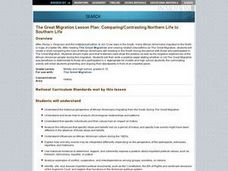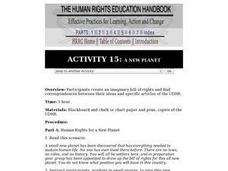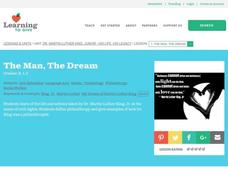Curated OER
Comparing/Contrasting Northern Life to Southern Life
Students compare and contrast the lives of African Americans who moved North vs. those who stayed in the South during the era of Jim Crow Laws.
Curated OER
Creating A Bill Of Rights In Space
Young scholars define rights, analyze and apply the U.S. Bill of Rights to hypothetical situations, and create an Intergalactic Bill of Rights.
Curated OER
Government Lesson Plan: Lesson Plan 9
Students examine and compare/contrast the steps of criminal and civil cases. They define key vocabulary terms, develop an outline of a criminal and civil trial, and analyze the differences in standards of proof in legal cases.
Curated OER
Using High Stakes Testing to Make Students and Schools Accountable for Learning
Students conduct an informal survey about their views on high stakes testing and use basic computation skills to evaluate results as a group. They participate in activities related to high stakes testing and "No Child Left Behind"...
Curated OER
One Person CAN Make a Difference
Middle schoolers illustrate how the actions of one person can make a difference. They identify school and community issues to address and complete group projects and action plans for making changes in the school or community.
Curated OER
Breaking the Code: Actions and Songs of Protest
Students listen to and discuss the purpose of protest music. They analyze an editorial cartoon related to Jim Crow and read questions from the literacy tests given to African-Americans. They work together to write a song about the...
Curated OER
A New Generation of Fighters
Students discuss the reasons why people are less likely to take a stand on issues today than they were in the past. In groups, they research the efforts of Kings, Parks and others to end discrimination and racism. They read excerpts of...
Curated OER
Civil Rights Webquest
Students, working individually and in teams, research life in their community during the civil rights era. They take part in a role-playing discussion about civil rights issues based on their research, and create individual and group...
Curated OER
Case in Point
Students read about and discuss the re-opening of the Emmett Till murder case. They research and write about a famous civil rights trial and create a poster highlighting the importance of the trial.
Curated OER
Continuity or Change? African Americans in World War II
Students examine the experience of African Americans during World War II by analyzing primary sources and formulating historical questions. They evaluate if the African American experience during World War II represents continuity or...
Curated OER
Martin Luther King
Students examine the contributions made by Martin Luther King Jr. They discuss civil rights, conduct research in small groups, participate in a discrimination simulation, and create a collage.
Curated OER
Giving Human Rights a Human Face
Young scholars produce a creative expression of an article of the Universal Declaration of Human Rights. They may also create posters to serve as reminders for creating a human rights environment or community.
Curated OER
Human Rights Education Handbook: A New Planet
Students create an imaginary bill of rights and find correspondences between their ideas and specific articles of the Universal Declaration of Human Rights.
Curated OER
Rosa Parks Changed the Rules
Students listen to a story about Rosa Parks and examine the bus seating rules of the 1950s. In this civil rights movement instructional activity, the teacher reads students a book about Rosa Parks, then students complete a worksheet...
Curated OER
The Man, The Dream
Students discuss how one person's life can affect a community . In this Martin Luther King Jr. lesson, students read about Dr. King's life and contributions. They formulate ideas about how they can meet the needs of their own community.
Curated OER
The Many Shades of Our World
Students discover diversity. In this civil rights activity, students consider that skin color is unique and that diversity is common in the world as they complete artwork that reflects the writings of Dr. Martin Luther King, Jr.
Curated OER
Picturing Freedom: Selma-to-Montgomery March, 1965
Students analyze primary sources to investigate the Civil Rights Movement. In this Civil Rights lesson, students explore the passage of Voting Rights Act of 1965 and how photojournalism impacted the passage of the legislation. Students...
Facing History and Ourselves
Denial and Free Speech
Learners explore the meaning and implications of genocide. For this Armenian genocide activity, learners investigate the genocide that took place in Turkey.
Curated OER
Nonviolence as a Tool for Change Lesson 2
Students explore nonviolent protest. In this Civil Rights lesson, students read the essay "Nonviolence and Racial Justice." Students present the information they gleaned from the essay to their classmates in order to consider how...
Curated OER
The March from Selma to Montgomery
Students examine voter discrimination. In this Civil Rights lesson, students watch segments of "Eyes on the Prize" and discuss the organization of the march from Selma to Montgomery. Students conduct interviews to learn...
Curated OER
Martin Luther King Jr.
Second graders discover contributions made to society by Martin Luther King Jr. For this civil rights history lesson, 2nd graders are read two books about Martin Luther King Jr., answer questions about the books, and complete...
Curated OER
Learning to Respect Each Other
Discover how important Martin Luther King Jr. is to our society. In this civil rights lesson, investigate how Dr. King was an advocate for nonviolence and how he fought for civil rights for all Americans. Read and analyze Dr. King's "I...
Curated OER
Eisenhower: The Contentious 1950s
Students explore 1950's America. In this American history lesson, students research the McCarthy hearings, Civil Rights, war fatigue, and economic issues of the decades. Students respond to discussion questions about topics.
Curated OER
Cartoons for the Classroom: Liberty vs. Security
In this current events learning exercise, students analyze a political cartoon about civil liberties and respond to 3 talking point questions.

























